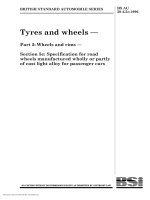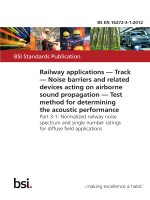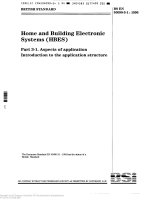Bsi bs en 60255 21 1 1996 (1999)
Bạn đang xem bản rút gọn của tài liệu. Xem và tải ngay bản đầy đủ của tài liệu tại đây (394.04 KB, 14 trang )
BRITISH STANDARD
Electrical relays —
Part 21: Vibration, shock, bump and
seismic tests on measuring relays and
protection equipment —
Section 1: Vibration tests (sinusoidal)
The European Standard EN 60255-21-1:1995 has the status of a
British Standard
BS EN
60255-21-1:
1996
IEC 255-21-1:
1988
Incorporating
Amendment No. 1
BS EN 60255-21-1:1996
Committees responsible for this
British Standard
The preparation of this British Standard was entrusted by the General
Electrotechnical Standards Policy Committee (GEL/–) to Technical Committee
GEL/5, upon which the following bodies were represented:
British Telecommunications plc
Electricity Supply Industry in England and Wales
Electronic Components Industry Federation
Transmission and Distribution Association (BEAMA Limited)
The following body was also represented in the drafting of the standard,
through subcommittees and panels:
Association of Consulting Engineers
This British Standard, having
been prepared under the
direction of the General
Electrotechnical Engineering
Standards Policy Committee,
was published under the
authority of the Board of BSI
and comes into effect on
30 November 1989
© BSI 07-1999
The following BSI references
relate to the work on this
standard:
Committee reference GEL/5
Draft for comment 86/27034 DC
ISBN 0 580 17986 9
Amendments issued since publication
Amd. No.
Date of issue
Comments
9095
September
1996
Indicated by a sideline in the margin
BS EN 60255-21-1:1996
Contents
Committees responsible
National foreword
Foreword
Text of EN 60255-21-1
Publications referred to
© BSI 07-1999
Page
Inside front cover
ii
2
3
Inside back cover
i
BS EN 60255-21-1:1996
National foreword
This Subsection of BS 142 has been prepared under the direction of the
General Electrotechnical Engineering Standards Policy Committee. It is
identical with IEC Publication 255-21-2:1988 “Electrical relays —
Part 21: Vibration, shock, bump and seismic tests on measuring relays and
protection equipment — Section 1: Vibration tests (sinusoidal) ”, published by
the the International Electrotechnical Commission (IEC).
NOTE This Subsection should be read in conjunction with BS 142-0 “General introduction and
list of Parts”.
In 1995 the European Committee for Electrotechnical Standardization
(CENELEC) accepted IEC 255-21-1:1988 as European Standard
EN 60255-21-1:1995. As a consequence of implementing the European Standard
this British Standard is numbered as BS EN 60255-21-1:1996 and any
reference to BS 142 Subsection 1.5.1:1989 should be read as reference to
BS EN 60255-21-1:1996.
Cross-references
International standard
Corresponding British Standard
BS 2011 Basic environmental testing procedures
Part 2.1 Tests
IEC 68-2-6:1982
Part 2.1 Fc:1983 Test Fc. Vibration (sinusoidal)
(Identical)
BS QC 160000 Harmonized system of quality
assessment for electronic components. Electrical relays.
Generic specification: electromechanical all-or-nothing
relays
IEC 255-7:1978
Part 1:1987 Test and measurement procedures
(Identical)
The international text refers to the International Electrotechnical Vocabulary.
The corresponding British Standard is BS 4727 Glossary of electrotechnical,
power, telecommunication, electronics, lighting and colour terms, of which
Part 1:Group 03 Relay terminology is particularly relevant. However, terms
specific to the needs of protection relays are to be found in BS 142-1.1.
General references to IEC 255 in this context should be taken as equivalent to
references to BS 142.
The British Standard related to ISO 2041:1975 is BS 3015 Glossary of terms
relating to mechanical vibration and shock.
A British Standard does not purport to include all the necessary provisions of a
contract. Users of British Standards are responsible for their correct application.
Compliance with a British Standard does not of itself confer immunity
from legal obligations.
Summary of pages
This document comprises a front cover, an inside front cover, pages i and ii,
the EN title page, pages 2 to 8, an inside back cover and a back cover.
This standard has been updated (see copyright date) and may have had
amendments incorporated. This will be indicated in the amendment table on the
inside front cover.
ii
© BSI 07-1999
EUROPEAN STANDARD
EN 60255-21-1
NORME EUROPÉENNE
November 1995
EUROPÄISCHE NORM
ICS 29.120.70
Descriptors: Measuring relays, sinusoidal vibration tests
English version
Electrical relays
Part 21: Vibration, shock, bump and seismic tests on
measuring relays and protection equipment
Section 1: Vibration tests (sinusoidal)
(IEC 255-21-1:1988)
Relais électriques
Partie 21: Essais de vibrations, de
chocs, de secousses et de tenue aux
séismes applicables aux relais de
mesure et aux dispositifs de protection
Section 1: Essais de vibrations
(sinusoïdales)
(CEI 255-21-1:1988)
Elektrische Relais
Teil 21: Schwing-, Schock-,
Dauerschock- und Erdbebenprüfungen
an Mrelais und Schutzeinrichtungen
Hauptabschnitt 1: Schwingprüfungen
(sinusfưrmig)
(IEC 255-21-1:1988)
This European Standard was approved by CENELEC on 1995-09-20;
CENELEC members are bound to comply with the CEN/CENELEC Internal
Regulations which stipulate the conditions for giving this European Standard
the status of a national standard without any alteration.
Up-to-date lists and bibliographical references concerning such national
standards may be obtained on application to the Central Secretariat or to any
CENELEC member.
This European Standard exists in three official versions (English, French,
German). A version in any other language made by translation under the
responsibility of a CENELEC member into its own language and notified to the
Central Secretariat has the same status as the official versions.
CENELEC members are the national electrotechnical committees of Austria,
Belgium, Denmark, Finland, France, Germany, Greece, Iceland, Ireland, Italy,
Luxembourg, Netherlands, Norway, Portugal, Spain, Sweden, Switzerland and
United Kingdom.
CENELEC
European Committee for Electrotechnical Standardization
Comité Européen de Normalisation Electrotechnique
Europäisches Komitee für Elektrotechnische Normung
Central Secretariat: rue de Stassart 35, B-1050 Brussels
© 1995 Copyright reserved to CENELEC members
Ref. No. EN 60255-21-1:1995 E
EN 60255-21-1:1995
Foreword
Contents
The text of the International Standard
IEC 255-21-1:1988, prepared by SC 41B1)
Measuring relays and protection equipment, of
IEC TC 41, Electrical relays, was submitted to the
Unique Acceptance Procedure and was approved by
CENELEC as EN 60255-21-1 on 1995-09-20
without any modification.
The following dates were fixed:
— latest date by which the EN
has to be implemented at
national level by
publication of an identical
national standard or by
endorsement
(dop) 1996-10-01
— latest date by which the
national standards
conflicting with the EN
have to be withdrawn
(dow) 1996-10-01
Annexes designated “normative” are part of the
body of the standard, Appendix A and Annex ZA are
normative. Annex ZA has been added by
CENELEC.
Endorsement notice
The text of the International Standard
IEC 255-21-1:1988 was approved by CENELEC as a
European Standard without any modification.
1) IEC
2
Foreword
1
Scope
2
Object
3
Definitions
3.1
Vibration test (sinusoidal)
3.2
Vibration response test
3.3
Vibration endurance test
3.4
Fixing point (*)
3.5
Measuring points (*)
3.6
Check point (*)
3.7
Reference point (*)
3.8
Sweep-cycle (*)
3.9
Distortion (*)
3.10 Cross-over frequency
3.11 Standard acceleration of gravity
4
Requirements for vibration
tests (sinusoidal)
4.1
Test apparatus and mounting
4.2
Test severity classes
4.3
Test procedure
5
Criteria for acceptance
5.1
Acceptance criteria for vibration
response test
5.2
Acceptance criteria for vibration
endurance test
Appendix A Output circuit response
during vibration response test
Annex ZA (normative) Normative
references to international publications
with their corresponding European
publications
Table I — Vibration response test
parameters for different severity classes
Table II — Vibration endurance test
parameters for different severity classes
Table III — Guide for selection of test
severity classes
Page
2
3
3
3
3
3
3
3
3
3
3
3
3
4
4
4
4
4
5
6
6
6
7
8
5
5
5
SC 41B has been replaced by IEC TC 95, Measuring relays and protection equipment.
© BSI 07-1999
EN 60255-21-1:1995
1 Scope
This standard is part of a series specifying the
vibration, shock, bump and seismic requirements
applicable to measuring relays and protection
equipment (with or without contacts).
This standard includes two types of vibration tests:
the vibration response test and the vibration
endurance test, and is generally based upon
IEC 68-2-6.
The requirements of this standard are applicable
only to measuring relays and protection equipment
in a new condition.
The tests specified in this standard are type tests.
2 Object
The object of this standard is to state:
— definitions of terms used;
— test conditions;
— standard test severity classes;
— test procedure;
— criteria for acceptance.
3 Definitions
For definitions of general terms not defined in this
standard, reference should be made to:
— International Electrotechnical Vocabulary
(IEV) [IEC 50];
— IEC 68-2-6;
— relay standards published in the IEC 255
series;
— ISO 2041.
For the purpose of this standard the following
definitions shall apply.
NOTE Definitions marked with (*) are derived from
IEC 68-2-6.
3.1
vibration test (sinusoidal)
a test during which a specimen is submitted to
sweeps of sinusoidal vibration in the three different
axes of the specimen in turn, in terms of constant
displacement and/or constant acceleration, within a
standard frequency range
NOTE The term “specimen” includes any auxiliary part which
is an integral functional feature of the measuring relay or
protection equipment under test.
3.2
vibration response test
a vibration test carried out on a measuring relay or
protection equipment, energized under specified
conditions, to determine its response to normal
service conditions
© BSI 07-1999
3.3
vibration endurance test
a vibration test carried out on a non-energized
measuring relay or protection equipment, with
higher vibration levels than in normal service
conditions, as an accelerated life test to simulate
long-term vibration. This test also simulates some
transportation conditions
3.4
fixing point (*)
part of the specimen in contact with the fixture or
vibration table at a point where the specimen is
normally fastened in service
if a part of the real mounting structure is used as the
fixture, the fixing points shall be taken as those of
the mounting structure and not of the specimen
3.5
measuring points (*)
the specific points at which data are obtained during
the tests. They are of two main types: check point
and reference point
3.6
check point (*)
a measuring point located on the fixture, on the
vibration table or on the specimen as close as
possible and rigidly connected to one of its fixing
points
3.7
reference point (*)
a measuring point chosen from the check points
whose signal is used to control the test so that the
requirements of this standard are satisfied
3.8
sweep-cycle (*)
a traverse of the specified frequency range once in
each direction, for example 10 Hz to 150 Hz
and 150 Hz to 10 Hz
3.9
distortion (*)
µ 2tot – µ 12
Distortion d = ----------------------------------- ´ 100 (percentage)
µ1
where:
a1
= r.m.s. value of the acceleration at the
driving frequency
atot = total r.m.s. value of the applied
acceleration (including the value of a1)
3
EN 60255-21-1:1995
3.10
cross-over frequency
that frequency at which the characteristic of a
vibration changes from a constant displacement
value versus frequency to a constant acceleration
value versus frequency
3.11
standard acceleration of gravity
the standard acceleration of gravity gn, where “n”
indicates normal, having the value of 9.81 m/s2. In
practice this value may be rounded to 10 m/s2
4 Requirements for vibration tests
(sinusoidal)
The main parameters of the vibration tests are the
following:
— frequency range;
— acceleration;
— displacement amplitude below the cross-over
frequency, if any,
— sweep rate and number of sweep cycles.
4.1 Test apparatus and mounting
The required characteristics of the vibration
generator and fixture together with the mounting
requirements shall be as follows. The
characteristics apply when the specimen is mounted
on the generator.
4.1.1 Basic motion
The basic motion shall be a sinusoidal function of
time and such that the fixing points of the specimen
move substantially in phase and in straight parallel
lines along a specified axis, subjected to the
limitations of Sub-clauses 4.1.2 and 4.1.3.
4.1.2 Transverse motion
The maximum vibration amplitude at the check
points in any axis perpendicular to the specified axis
shall not exceed 50 % of the specified amplitude for
basis motion.
4.1.3 Distortion
The acceleration distortion measurement shall be
carried out at the reference point, which shall be
declared by the manufacturer, and shall cover the
frequencies up to 5 000 Hz.
The distortion as defined in Sub-clause 3.9 shall not
exceed 25 %. In cases where a distortion value
greater than 25 % is obtained, the distortion shall
be noted and agreed between manufacturer and
user.
4
4.1.4 Vibration amplitude tolerances
The actual vibration displacement and acceleration
amplitude along the required axis of the reference
point shall be equal to the specified value, within a
tolerance of ± 15 %.
4.1.5 Frequency range tolerances
The frequency range shall be equal to the specified
values (Sub-clauses 4.2.1 and 4.2.2) within the
following tolerances:
— ± 1 Hz for the lower frequency 10 Hz;
— ± 3 Hz for the upper frequency 150 Hz.
4.1.6 Sweep
The sweeping shall be continuous and the frequency
shall change exponentially with time.
The sweep rate shall be 1 octave per minute ± 10 %.
NOTE in particular cases a lower sweep rate can be chosen, e.g.
for relays and protection equipment having an operating time
greater than 8 min.
4.1.7 Mounting
The specimen shall be fastened to the vibration
generator or fixture by its normal means of
attachment in service so that the gravitational force
acts on it in the same relative direction as it would
in normal use.
During the vibration response test, cable
connections to the specimen shall be so arranged
that they impose no more restraint or mass than
they would when the specimen is installed in its
operating position.
NOTE Care should be taken to ensure that the specimen under
test is not significantly affected by any magnetic field generated
by the vibration system.
4.2 Test severity classes
The vibration response test and the vibration
endurance test include three different severity
classes (0, 1, 2), the main parameters of which are
referred to in Sub-clauses 4.2.1 and 4.2.2 below.
For particular types of measuring relays or
protection equipment, the manufacturer may
declare different severity classes for the vibration
response test and the vibration endurance test.
When Class 0 is declared, no vibration tests apply.
4.2.1 Vibration response test
The frequency range for this test is 10 Hz to 150 Hz
and the crossover frequency is 58 Hz to 60 Hz.
Table I below gives the main parameters of the test
severity classes.
© BSI 07-1999
EN 60255-21-1:1995
Table I — Vibration response test parameters for different severity classes
Peak acceleration above the
cross-over frequency (gn)
Peak displacement below the
cross-over frequency (mm)
Class
Number of sweep
cycles in each axis
0
—
—
—
1
0.035
0.5
1
2
0.075
1.0
1
NOTE For the frequency range of 10 Hz to 150 Hz and a sweep
rate of 1 octave per minute, 1 sweep cycle corresponds to a test
time of about 8 min.
4.2.2 Vibration endurance test
The nominal frequency range for this test is
also 10 Hz to 150 Hz; however this test shall be
carried out with constant acceleration. Table II
below gives the main parameters of the test severity
classes.
Table II — Vibration endurance test
parameters for different severity classes
Class
0
1
2
Peak acceleration
(gn)
Number of sweep cycles
in each axis
—
1.0
2.0
—
20
20
NOTE For the frequency range of 10 Hz to 150 Hz and a sweep
rate of 1 octave per minute, 20 sweeps correspond to a test time
of about 160 min.
4.2.3 Recommendations for the selection of test
severity classes
The test severities are classified with respect to the
ability of a measuring relay or protection equipment
to withstand the mechanical vibrations likely to be
experienced in a particular transportation or type of
use, in accordance with Table III below.
Table III — Guide for selection of test
severity classes
Class
0
1
2
Typical applications
Measuring relays and protection
equipment for which there are no
vibration requirements
Measuring relays and protection
equipment for normal use in power
plants, substations and industrial
plants and for normal transportation
conditionsa
Measuring relays and protection
equipment for which a very high
security margin is required or where
the vibration levels are very high,
e.g. shipboard application and for
severe transportation conditionsa
a The
packaging of the measuring relay or protection
equipment should be designed and implemented in such a
manner that the severity class parameters will not be exceeded
during transportation.
© BSI 07-1999
4.3 Test procedure
The vibration displacement and acceleration
amplitudes shall be measured at the reference
point, which shall be declared by the manufacturer.
NOTE If the size of a specimen makes it impracticable to test it
as a whole, it may be tested as functional sub-units as agreed
between manufacturer and user.
4.3.1 The vibration response test shall be carried
out on a measuring relay or protection equipment
under reference conditions stated in the relevant
relay standard, published in the IEC 255 series and
with the following values of energizing quantities
(auxiliary and input) and loading applied to the
appropriate circuits:
— auxiliary energizing quantity(ies): rated
value(s);
— output circuit loadings: no loading except the
monitoring device or loading as declared by the
manufacturer;
— input energizing quantity(ies): values equal to
the operating value of the characteristic quantity
plus and minus the manufacturer’s declared
variation for no maloperation due to vibrations;
see items a) and b) below:
a) The value of the characteristic quantity
shall be below the operating value for
maximum measuring relay or protection
equipment (above for minimum measuring
devices). The relay shall not operate.
b) The value of the characteristic quantity
shall be above the operating value for
maximum measuring relay or protection
equipment (below for minimum measuring
devices.) The relay shall not release.
Prior to the test the operating value(s) of measuring
relays or protection equipment shall be measured
under reference conditions.
4.3.2 During the vibration response test, the
measuring relay or protection equipment shall have
its operating value(s) set at highest sensitivity.
By agreement between manufacturer and user,
measuring relays and protection equipment may be
classified at other settings.
NOTE When testing protection equipment which includes
several measuring functions the vibration response test may be
carried out to check only the function most sensitive to vibration,
if known.
5
EN 60255-21-1:1995
4.3.3 During the vibration response test, the state of
the output circuits (see Sub-clause 5.1.1) shall be
determined by a monitoring device which measures
the duration of the output circuit change of state, if
any. The time-measuring circuit of this monitoring
device shall have a reset time of 0.2 ms, or less, in
order to prevent it from responding to the integrated
effect of a number of short-duration changes of state
of the output circuit, e.g. contact (see Appendix A).
4.3.4 The vibration endurance test shall be carried
out, without energizing quantities or loads
connected to the measuring relay or protection
equipment, under the reference conditions stated in
the relevant relay standard.
4.3.5 The measuring relay or protection equipment
shall be tested in its case with the cover, if any, in
position, and any transportation restraints
removed.
4.3.6 The effects of the vibrations on the specimen
under test shall be checked during and after the
vibration response test and after the vibration
endurance test.
6
5 Criteria for acceptance
5.1 Acceptance criteria for vibration response
test
5.1.1 During the test, the measuring relay or
protection equipment shall not maloperate. It is
considered not to have maloperated if the normal
state(s) of its output circuit(s) has/have not changed
for more than 2 ms.
NOTE The manufacturer may also declare the values of peak
acceleration and/or peak displacement for which no change of
state longer than 10 4s occurs (see Appendix A).
5.1.2 The test shall not cause flags, or other forms of
indications, to change their state permanently.
5.1.3 After the test, the measuring relay or
protection equipment shall still comply with the
relevant performance specification and shall not
have changed its setting by more than 0.5 times the
assigned error, nor have suffered mechanical
damage.
5.2 Acceptance criteria for vibration
endurance test
5.2.1 The test may cause flags, or other forms of
indications, to change their state.
5.2.2 After the test, the measuring relay or
protection equipment shall still comply with the
relevant performance specification and shall not
have suffered mechanical damage.
© BSI 07-1999
EN 60255-21-1:1995
Appendix A Output circuit response during vibration response test
An increasing number of applications of measuring relays and protection equipment may include devices,
e.g. thyristors, with very short operating times for which the test requirements of 2 ms may be inadequate.
It is desirable to know the peak acceleration and peak displacement for which there is no risk of the output
circuit changing state. For amplitudes above these values there would, for example, be a risk of a contact
being damaged by attempting to interrupt the resulting output circuit load current after a momentary
change of state caused by vibration.
Insufficient data are at present available for many designs of relays and protection equipment to make
realistic proposals for standard acceleration and displacement amplitude withstand values at which no
undesirable change of state will occur.
In order to obtain these data, it is recommended that measuring relays and protection equipment should
be tested in accordance with Subclause 4.3 but with an acceptance criterion of 10 4s for the change of state
of the output circuit, as in Clause 39 of IEC 255-7. The results should be declared by the manufacturer.
For guidance, it should be noted that measurements made on measuring relay cases in several power
stations indicate that the peak acceleration to be expected in service is typically not above 0.1 gn.
© BSI 07-1999
7
EN 60255-21-1:1995
Annex ZA (normative)
Normative references to international publications with their corresponding
European publications
This European Standard incorporates by dated or undated reference, provisions from other publications.
These normative references are cited at the appropriate places in the text and the publications are listed
hereafter. For dated references, subsequent amendments to or revisions of any of these publications apply
to this European Standard only when incorporated in it by amendment or revision. For undated references
the latest edition of the publication referred to applies (including amendments).
NOTE When an international publication has been modified by common modifications, indicated by (mod), the relevant EN/HD
applies.
Publication
Year
Title
EN/HD
IEC 50
series
International electrotechnical vocabulary (IEV)
—
IEC 68-2-6
1982
Basic environmental testing procedures
Part 2: Tests — Test Fc and guidance: Vibration
(Sinusoidal)
HD 323.2.6 S2
IEC 255-7
1978
Electrical relays — Part 7: Test and measurement
—
procedures for electromechanical all-or-nothing relays
—
ISO 2041
1975
Vibration and shock — Vocabulary
—
—
a
8
Year
—
a
1988
HD 323.2.6 S2 is superseded by EN 60068-2-6:1995, which is based on IEC 68-2-6:1995.
© BSI 07-1999
BS EN 60255-21-1:1996
Publications referred to
See national foreword
© BSI 07-1999
BS EN
60255-21-1:
1996
IEC 255-21-1:
1988
BSI — British Standards Institution
BSI is the independent national body responsible for preparing
British Standards. It presents the UK view on standards in Europe and at the
international level. It is incorporated by Royal Charter.
Revisions
British Standards are updated by amendment or revision. Users of
British Standards should make sure that they possess the latest amendments or
editions.
It is the constant aim of BSI to improve the quality of our products and services.
We would be grateful if anyone finding an inaccuracy or ambiguity while using
this British Standard would inform the Secretary of the technical committee
responsible, the identity of which can be found on the inside front cover.
Tel: 020 8996 9000. Fax: 020 8996 7400.
BSI offers members an individual updating service called PLUS which ensures
that subscribers automatically receive the latest editions of standards.
Buying standards
Orders for all BSI, international and foreign standards publications should be
addressed to Customer Services. Tel: 020 8996 9001. Fax: 020 8996 7001.
In response to orders for international standards, it is BSI policy to supply the
BSI implementation of those that have been published as British Standards,
unless otherwise requested.
Information on standards
BSI provides a wide range of information on national, European and
international standards through its Library and its Technical Help to Exporters
Service. Various BSI electronic information services are also available which give
details on all its products and services. Contact the Information Centre.
Tel: 020 8996 7111. Fax: 020 8996 7048.
Subscribing members of BSI are kept up to date with standards developments
and receive substantial discounts on the purchase price of standards. For details
of these and other benefits contact Membership Administration.
Tel: 020 8996 7002. Fax: 020 8996 7001.
Copyright
Copyright subsists in all BSI publications. BSI also holds the copyright, in the
UK, of the publications of the internationalstandardization bodies. Except as
permitted under the Copyright, Designs and Patents Act 1988 no extract may be
reproduced, stored in a retrieval system or transmitted in any form or by any
means – electronic, photocopying, recording or otherwise – without prior written
permission from BSI.
This does not preclude the free use, in the course of implementing the standard,
of necessary details such as symbols, and size, type or grade designations. If these
details are to be used for any other purpose than implementation then the prior
written permission of BSI must be obtained.
BSI
389 Chiswick High Road
London
W4 4AL
If permission is granted, the terms may include royalty payments or a licensing
agreement. Details and advice can be obtained from the Copyright Manager.
Tel: 020 8996 7070.









